| year by year |
1953 - 1962
First generation Corvette...

|
1963 - 1967
Second generation Corvette...

|
1968 - 1982
Third generation Corvette...

|
1984 - 1996
Fourth generation Corvette...

|
1997 - 2004
Fifth generation Corvette...

|
2005 - Present
Sixth generation Corvette...

|
Future
Seventh generation Corvette...

|
 |
|
| |
1964 Corvette
|
With the Sting Ray on such a roll, it was prudent for Chevrolet to make only evolutionary changes to the 1964 Corvette. Besides the coupe's backbone window, the two simulated air intakes were eliminated from the hood, though their indentations remained. Also, the decorative air-exhaust vent on the coupe's rear pillar was made functional, but only on the left side. The car's rocker-panel trim lost some of its ribs and gained black paint between those ribs that remained; wheel covers were simplified; and the fuel filler/deck emblem gained concentric circles around its crossed-flags insignia. Inside, the original color-keyed steering wheel rim was now done in simulated walnut.
The 1963 model's shock absorbers tended to weaken as the miles rolled by, and owners began complaining of deteriorating ride quality. Chevrolet solved this problem with a few suspension refinements for 1964. The front coil springs were changed from constant-rate to progressive or variable-rate and were more tightly wound at the top, while leaf thickness of the rear transverse spring was also altered. With their wider damping range, the revised springs could better absorb both large and small disturbances, thus providing a more comfortable ride with no sacrifice in handling.
Shock absorbers were reworked toward the same end. When subjected to frequent oscillation at near full vertical wheel travel, such as on very rough roads, the standard 1963 shocks tended to overheat. The 1964 Corvette arrived with a new standard shock containing within its fluid reservoir a small bag of Freon gas that absorbed heat.
Chevy added more sound insulation and revised body and transmission mounts for the 1964 Corvette. It also fitted additional bushings to quiet the shift linkage and placed a new boot around the lever. The result was a more livable car for everyday transportation.
Drivetrain choices remained basically as before: four 327 cid V-8s, one three- and two four-speed manual transmissions and the Powerglide automatic, and six axle ratios. The two least-powerful engines returned with 250 and 300 bhp on 10.5:1 compression, but the high-performance pair received several noteworthy improvements. The solid-lifter unit was massaged with a high-lift, long-duration camshaft to produce 365 bhp and breathed through a big four-barrel Holley carburetor instead of the base engine's Carter unit. This was an advantage, since the Holley was more easily tailored to specific needs because a larger assortment of performance pieces were available for it. The fuelie also gained 15 horsepower, bringing its total to 375. But at a then-hefty $538, it was too rich for most buyers' budgets.
Although transmission options remained ostensibly the same for 1964, the two Borg-Warner T-10 four-speeds gave way to a similar pair of gearboxes built at GM's Muncie, Indiana, transmission facility. Originally a Chevy design, it had an aluminum case like the B-W box but came with stronger synchronizers and wider ratios for better durability and drivability. The wide-ratio version could be teamed only with the 250- and 300-bhp powerplants; gear spacings were 2.56:1, 1.91:1, 1.40:1, and 1.00:1. The close-ratio unit was for the more potent mills; its internals were 2.20:1, 1.64:1, 1.28:1, and 1.00:1. Like the B-W boxes, the Muncies had a reverse lockout trigger, but with a thicker shifter.
Positraction was still a bargain-priced option in 1964 at only $43.05, and it went into more than 80 percent of that year's production. The clutch-type differential was designed to send engine torque to the wheel with greater traction, as opposed to a standard open differential that transfers power to the wheel with lesser traction.
The J56 sintered-metallic brakes were a much costlier option -- a whopping $629.50 -- though you also got the Al-Fin drums. While the J56 brakes were not as easily modulated as the disc brakes that would come in subsequent years, they provided plenty of fade-free stopping power.
If enthusiast publications liked the first Sting Ray, they loved the 1964, though some writers noted the convertible's tendency to rattle and shake on rough roads. Motor Trend clocked a fuel-injected four-speed coupe with the 4.11:1 rear axle, aluminum knock-off wheels (perfected at last and available from the factory), the sintered-metallic brakes, and Positraction through the quarter-mile in 14.2 seconds at 100 mph and streaked from 0 to 60 mph in just 5.6 seconds. At the opposite end of the spectrum, Road & Track tested the tame 300-bhp Powerglide setup in a '64 coupe and recorded a 0-60-mph time of 8.0 seconds, a standing-quarter in 15.2 seconds at 85 mph, and average fuel consumption of 14.8 mpg.
Sales of the 1964 Sting Ray reached 22,229 -- another new Corvette record, if up only a little from banner-year 1963. Coupe volume dropped to 8304 units, but convertible sales more than compensated, rising to 13,925.
|
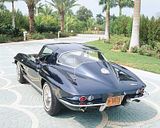
The 1964 Corvette Sting Ray eliminated the distinctive split rear window of 1963.
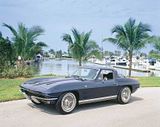
1964 Prototypes

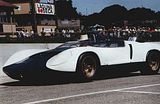
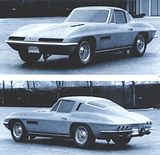

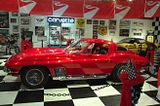

|
1964 Corvette Specifications
The 1964 Corvette Sting Ray carried improved suspension features and more sound insulation to provide a quiet, powerful ride. Here are the specifications for the 1964 Corvette Sting Ray:
Vehicle Specifications
|
Convertible
|
Coupe |
Wheelbase, inches
|
98.0
|
98.0 |
Length, inches
|
175.3
|
175.3 |
Width, inches
|
69.6
|
69.6 |
Track, inches
|
front: 56.3 rear: 57.0
|
front: 56.3 rear: 57.0 |
Height, inches
|
49.8
|
49.8 |
Curb weight, pounds
|
3,180
|
3,180 |
Mechanical Specifications (2-door convertible/coupe)
Suspension
front:Independent; upper and lower A-arms, coil springs, antiroll bar, tubular hydraulic shock absorbers
rear: Fixed differential, U-jointed half shafts, lateral struts, radius rods, transverse leaf spring, tubular hydraulic shock absorbers, antiroll bar w/big block engines
Wheels/Tires
6.70x15
Brakes
front: 11-inch drum
rear: 11-inch drum
Transmission
3-speed manual (std)
4-speed manual (opt)
2-speed Powerglide (opt)
Standard axle ratio
3.70:1
Engine Specifications
| Type |
ohv V-8 |
ohv V-8 |
ohv V-8 |
ohv V-8 |
| Displacement, liters/cu inch |
5.35/327
|
5.35/327 |
5.35/327 |
5.35/327 |
| Bore x stroke, inches |
4.00 x 3.25 |
4.00 x 3.25 |
4.00 x 3.25 |
4.00 x 3.25 |
| Fuel Management |
1 x 4-bbl. |
1 x 4-bbl. (AFB)
|
1 x 4-bbl. (AFB)
|
fuel injection
|
| Horsepower @ rpm |
250 @ 4400 |
300 @ 5000 |
365 @ 6200 |
375 @ 6200 |
| Torque @ rpm, pound-foot |
350 @ 2800 |
360 @ 3200 |
350 @ 4000 |
350 @ 4400 |
Published Performance Numbers
Acceleration
|
300 hp, 3-sp automatic |
0-60 mph, sec
|
8.0 |
0-100 mph, sec
|
20.2 |
1/4-mile, sec @ mph
|
15.2 @ 85 |
Vehicle Production and Base Prices
Car Type
|
Production
|
Price |
2-door convertible
|
13,925
|
$4,037.00 |
2-door coupe
|
8,304
|
4,252.00 |
Options and Production
Option
|
Production
|
Price |
Leather Seats
|
1,334
|
$80.70 |
Soft Ray Tinted Glass, all
|
6,031
|
16.15 |
Soft Ray Tinted Glass, windshield
|
6,387
|
10.80 |
| Power Windows |
3,706
|
59.20 |
Auxiliary Hardtop
|
7,023
|
236.75 |
Heater and Defroster Delete (credit)
|
60
|
100.00 |
Air Conditioning
|
1,998
|
421.80 |
Special Front and Rear Suspension
|
82
|
37.70 |
Positraction Rear Axle, all ratios
|
18,279
|
43.05 |
Highway Rear Axle, 3.08:1
|
2,310
|
2.20 |
Power Brakes
|
2,270
|
43.05 |
Sintered Metallic Brake Package
|
29
|
629.50 |
Sintered Metallic Brakes, power
|
4,780
|
53.80 |
Transistor Ignition System
|
552
|
75.35 |
300 hp Engine
|
10,471
|
53.80 |
365 hp Engine
|
7,171
|
107.60 |
375 hp Engine FI
|
1,325
|
538.00 |
| 4-speed Manual Transmission |
19,034
|
188.30 |
Powerglide Automatic Transmission
|
2,480
|
199.10 |
36 Gallon Fuel Tank (coupe)
|
38
|
202.30 |
Off Road Exhaust System
|
1,953
|
37.70 |
Power Steering
|
3,126
|
75.35 |
Cast Aluminum Knock-Off Wheels
|
806
|
322.80 |
Blackwall Tires, 6.70 x 15 nylon
|
372
|
15.70 |
| Whitewall Tires, 6.70 x 15 |
19,977
|
31.85 |
Back Up Lamps
|
11,085
|
10.80 |
AM/FM Radio
|
20,934
|
176.50 |
Color Choices and Production
Color Choice
|
Production |
Color Choice
|
Production |
| Tuxedo Black |
1,897
|
Silver Blue
|
3,121 |
Daytona Blue
|
3,454
|
Riverside Red
|
5,274 |
Saddle Tan
|
1,765
|
Ermine White
|
3,909 |
Sebring Silver
|
2,785
|
|
|
|
|
|
|